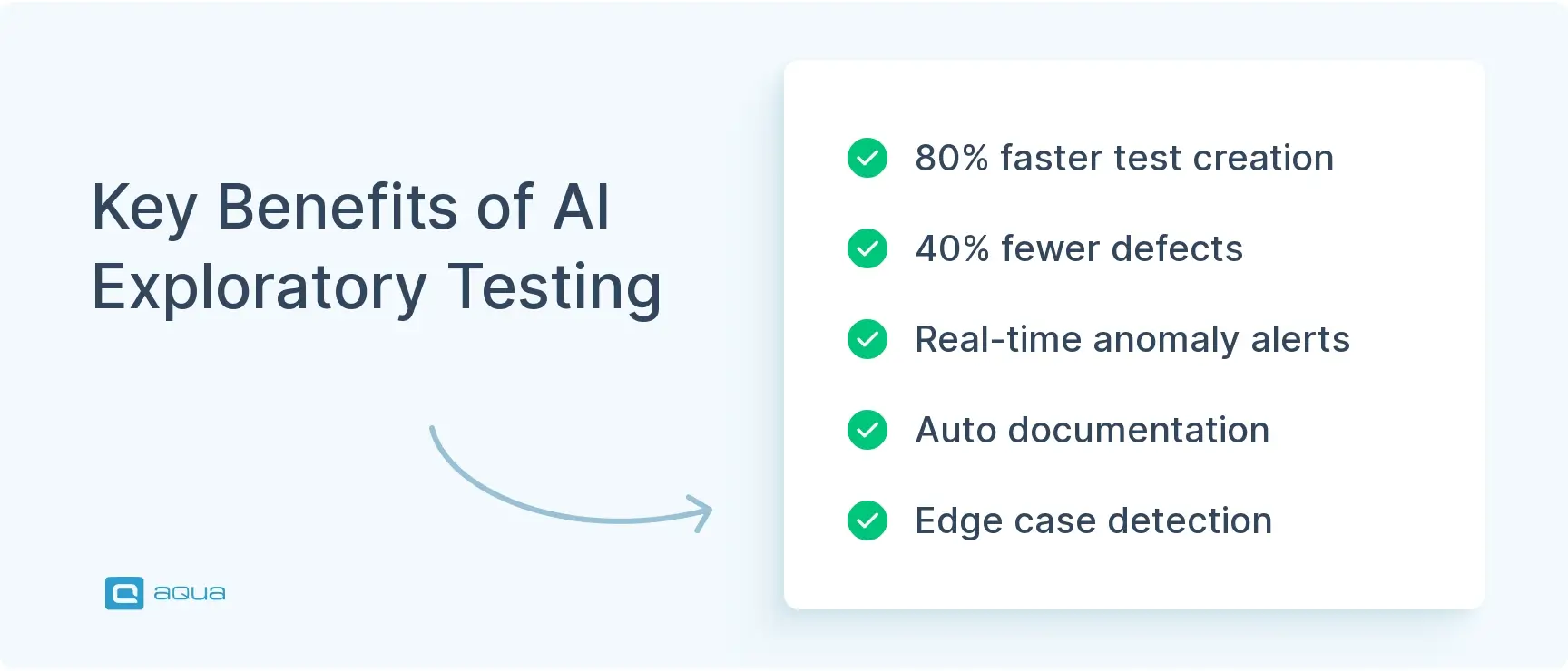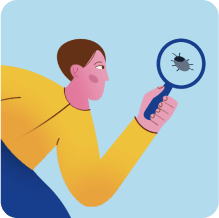Key Takeaways
- AI-powered exploratory testing tools learn from applications, predict potential issues, and adapt to changes in real-time, resulting in 80% faster test creation and 40% fewer production defects.
- Intelligent test scenario generation analyzes application behavior, historical defect patterns, and user stories to suggest exploratory paths that humans might overlook.
- AI automatically documents exploratory sessions, converting unstructured notes into formal test cases and defect reports through natural language processing.
- Implementation requires a phased approach: auditing current processes, selecting pilot projects, training teams on AI fundamentals, and validating results before expanding.
- Common challenges include data quality concerns, insufficient AI expertise among QA teams, integration complexity with existing workflows, and persistent trust issues with AI-generated outputs.
While AI won’t replace human creativity in testing, it transforms what testers can accomplish by handling repetitive tasks and uncovering edge cases humans might miss. Ready to see how AI could revolutionize your testing workflow? Read the full breakdown below 👇
What is Exploratory Testing?
Exploratory testing is simultaneous learning, test design, and execution. You don’t follow predefined steps. You investigate, adapt, and discover issues based on your instincts and domain knowledge. Instead of checking boxes, you actively probe the application. You follow your curiosity about how features interact, and find problems that scripted tests miss.
This approach works best in specific scenarios:
- Early stage development, when requirements are still fluid and you’re figuring out what the application should even do
- Complex products where predefined test cases don’t exist yet, because nobody fully understands the system
- Agile sprint cycles that need rapid feedback without waiting for comprehensive test suites
- Usability and UX evaluation where human perception matters more than automated checks
- Dynamic modules with minimal documentation, where you learn the application while testing it
Traditional exploratory testing hits walls, though. One tester can only explore so much in a session. Human biases and fatigue create blind spots. Documenting sessions feels like administrative overhead. Replicating insights across team members isn’t straightforward. These constraints are where AI enters. Not to replace your exploratory instincts, but to amplify what you can accomplish in the time you have.
How AI Can Improve the Exploratory Testing Process?
AI reshapes what’s possible in exploratory testing in different ways. It helps you analyze patterns humans miss and automate repetitive discovery tasks. This lets you focus on high-value exploration that demands creativity and judgment.
Intelligent test scenario generation
AI analyzes your application’s behavior, historical defect patterns, and user stories to suggest exploratory paths you might overlook. Machine learning identifies high-risk code areas and usage patterns, directing your attention where it matters most. You get data-driven recommendations based on actual risk factors instead of guessing which features need deeper exploration.
Real time anomaly detection
During exploratory sessions, AI captures your test activities and analyzes application responses in real time. It surfaces unexpected state transitions, performance hiccups, or edge cases as they happen. Computer vision, combined with ML, spots visual regressions or UI inconsistencies. Traditional pixel comparison tools miss or flag them incorrectly.
Implementing AI for exploratory testing is all about finding a solution that seamlessly integrates with your testing process while maximizing efficiency. That’s where aqua cloud stands out. While you’re evaluating your current QA processes and looking for high-impact areas as mentioned in this article, aqua’s domain-trained AI Copilot can transform your approach to exploratory testing from day one. Unlike generic AI tools, aqua’s Copilot is grounded in your project’s actual documentation and context, making every suggestion specifically relevant to your application. With features like intelligent test scenario generation and automated documentation, aqua helps your team focus on creative exploration while reducing test creation time by up to 98% and saving more than 12 hours weekly per tester. The platform seamlessly bridges the gap between manual exploratory insights and structured test management, turning your discoveries into reusable assets.
Transform exploratory testing from a manual bottleneck to an AI-powered advantage with aqua cloud
Automated documentation and artifact creation
Let’s admit it, nobody enjoys writing test documentation. AI transforms your exploratory sessions into structured artifacts automatically. Natural language processing converts your unstructured notes and observations into formal test cases, defect reports, and reusable scenarios. You spend time exploring instead of documenting, and your insights don’t get lost in meeting notes or Slack threads.
Edge case and boundary discovery
AI excels at systematic edge case generation. It identifies extreme inputs, unusual user flows, or boundary conditions that we, as humans, might not think of. AI analyzes requirements and code to dynamically generate tests for scenarios like exceptionally long queries, fluctuating network conditions, or rapid simultaneous user interactions. You get comprehensive coverage without manually brainstorming every possible corner case.
Predictive defect detection
Machine learning models analyze past projects, code changes, and usage data to predict where defects are most likely to occur. This shifts your exploratory testing from reactive to proactive. You investigate high-risk areas before issues manifest, not after. Organizations using predictive analytics report a 40% reduction in defect leakage by focusing exploratory effort where it delivers maximum impact, realizing key AI test automation benefits.
Self-healing test maintenance
When UI elements change, AI-powered systems detect the updates and automatically adjust test locators without manual intervention. Your exploratory test scripts remain stable even as developers refactor code, eliminating the maintenance burden that typically kills automation initiatives. You explore new features instead of fixing broken tests.
These improvements create a testing workflow that’s faster, more thorough, and less dependent on individual tester availability. But knowing the benefits is one thing. Implementing them requires a structured approach.

How to Implement AI in Exploratory Testing?
Maximizing the role of AI in exploratory testing takes a structured approach. Quick wins first, then long-term transformation. Here’s what actually works in production environments.
Step 1: Audit your current QA processes
Map where your team spends time and where defects slip through. Identify high-impact areas where AI can deliver early wins: modules with frequent UI changes, complex user flows, or historical defect hotspots. Document baseline metrics like test creation time, maintenance overhead, and post-release defect rates. These numbers become your proof points when justifying broader adoption.
Step 2: Select a pilot project
Choose one application or module with moderate complexity and decent historical data. You want enough substance to demonstrate AI’s value without so much complexity that your first attempt becomes a science experiment. Cross-browser testing or responsive design validation often makes excellent pilots because they’re painful manually but straightforward to automate with AI-powered tools.
Step 3: Evaluate and choose your AI testing platform
Test drive 2 to 3 leading tools against your specific use cases. Look for codeless or low-code interfaces that enable broad team participation, not just automation specialists. Assess integration with your existing CI/CD pipeline, test management platforms, and development workflows. Transparent pricing and vendor responsiveness matter. You don’t want surprises six months in.
Step 4: Train your team on fundamentals
Invest in structured training covering AI basics, NLP concepts, and the specific tool you’ve selected. Your testers need to understand how AI generates recommendations, what prompts yield better results, and how to validate AI-generated outputs. This is change management. Help people understand how their roles evolve.
Step 5: Deploy with human oversight
Launch your pilot with explicit oversight processes. AI generates test cases or suggests exploratory paths, but humans review and approve before execution. This maintains quality control while building trust in the system. Document what works, what doesn’t, and refine your prompts or parameters based on real feedback from actual test sessions.
Step 6: Measure, document, and communicate results
Track the same baseline metrics you established in Step 1. Calculate time saved, maintenance reduction, and defect detection improvements. Build internal case studies showing ROI (not just efficiency gains, but business impact like faster releases or reduced production incidents). Share these wins broadly to build momentum for broader adoption.
Step 7: Expand systematically across applications
Once you’ve proven the concept, roll out to additional applications with similar characteristics. Enhance your CI/CD integration so AI-generated tests execute automatically on code commits. Establish governance frameworks ensuring compliance, security, and ethical AI usage. Create feedback loops where test execution data continuously refines your AI models.
Step 8: Optimize and embrace emerging capabilities
As your team gains proficiency, explore advanced features like generative AI in testing for autonomous decision making or shift right testing that incorporates production data. Keep refining your approach based on what you learn. AI in software testing evolves constantly. Organizations seeing sustained ROI treat this as ongoing capability evolution, not a one-time project.
Implementation success depends on realistic expectations and systematic progress. You’re not replacing testers. You’re equipping them with capabilities that were science fiction five years ago.
Even with careful implementation, you’ll hit obstacles. Let’s address those head-on.
Challenges of AI-Driven Exploratory Testing
AI testing comes with friction you need to anticipate and address. Here’s what you’ll (or already do) actually encounter when implementing AI-driven exploratory testing.
Data quality and bias concerns
Your AI models are only as good as the data they’re trained on. If your historical test data skews toward certain user flows or device types, the AI inherits those blind spots. Biased training data produces biased test cases. It potentially overlooks critical functionalities or user segments. This requires ongoing data governance: validating training datasets, diversifying test scenarios, and continuously monitoring for skewed outputs.
Insufficient AI and ML expertise
Most QA teams weren’t hired for their machine learning skills. Understanding how models are trained, validated, and deployed requires capabilities many testers don’t yet have. You need to invest in upskilling existing staff or bring in specialists who can bridge the gap between traditional QA and AI capabilities. This knowledge gap creates immediate adoption friction. Tools sit unused because teams don’t fully understand how to leverage them.
Weak financial justification and ROI uncertainty
Despite clear efficiency gains, many organizations struggle to quantify AI testing ROI in terms that resonate with finance teams. How do you put a dollar figure on “faster exploratory coverage” or “better edge case discovery”? Without concrete ROI calculations tied to business outcomes, securing budget and stakeholder buy-in becomes an uphill battle.
Integration complexity with existing workflows
Plugging AI tools into established CI/CD pipelines, test management platforms, and development ecosystems isn’t always straightforward. Legacy systems, custom frameworks, and organizational chaos create technical and political hurdles. Teams underestimate the effort required to make AI-generated tests work with existing automation infrastructure.
Lack of trust in AI outputs
Testers and managers often remain skeptical of AI-generated tests, especially when the reasoning isn’t transparent. “Why did the AI suggest this test case?” or “How do I know this covers what I need?” These questions reveal a fundamental trust gap. Without explainable AI or clear validation processes, you might treat AI recommendations as interesting suggestions rather than reliable testing strategies.
Privacy and data confidentiality risks
Sending proprietary code or test data to cloud-based AI services raises legitimate security and compliance concerns. Regulated industries face additional constraints around data handling, making adoption slower and more complex. Organizations need clear data governance policies before using AI tools across their testing portfolio.
Test script maintenance despite self-healing claims
AI reduces maintenance but doesn’t eliminate it entirely. Self-healing mechanisms work best on straightforward UI changes but struggle with architectural refactors or major design overhauls. Teams discover they still need human oversight to ensure tests remain meaningful as applications evolve.
False positives and noise generation
AI-powered visual testing or anomaly detection can surface differences that aren’t actual defects: dynamic content, rendering variations, or environmental noise. Without proper tuning, teams drown in false alarms, eroding confidence in the system. Learning to configure thresholds and filters becomes its own specialized skill.
These challenges aren’t necessarily showstoppers, but they’re real. If you want to succeed with AI testing, acknowledge these obstacles upfront, build mitigation strategies, and set realistic expectations about the journey ahead. Let’s look at the tools actually delivering on AI’s exploratory testing promise.
What automation can't do (and "AI" can't do either) is higher cognitive value work. It can't sit in requirements meetings and say "Is that what you really meant?" or "How about this?" or "Historically our users have hated it when we do x..."
It can't assume a role and do exploratory work in an area, looking not just for a checklist, but a behavioural pattern.
Best AI Tools for Exploratory Testing
Choosing the right AI testing platform can mean the difference between transformative ROI and expensive shelfware. Here’s a look at tools delivering real value for exploratory testing workflows.
aqua cloud
Exploratory testing finds bugs your scripts miss, but documenting sessions and scaling insights across teams takes forever. aqua cloud solves this with a domain-trained AI Copilot that learns from your project’s actual documentation and context. Every suggestion is specifically relevant to your application, not generic advice. The platform transforms exploratory discoveries into reusable test assets automatically, cutting test creation time by up to 98% and saving more than 12 hours weekly per tester. You focus on creative exploration. AI handles documentation and test generation. aqua seamlessly bridges manual exploratory insights with structured test management, turning your discoveries into assets the whole team can use. Organizations using aqua report 60% faster releases and 15% weekly man-hour savings while keeping data secure and private.
Experience 60% faster releases and save 12+ hours weekly with AI exploratory testing that truly understands your product
testRigor
This platform lets you describe exploratory scenarios in plain English. The system translates them into stable, self-healing test cases. You’re not wrestling with selectors or fragile locators, just writing instructions like “click on the login button” or “verify the cart total is correct.” testRigor learns from production user behavior, generating tests based on actual usage patterns rather than hypothetical scenarios. Strong choice for teams lacking deep automation expertise.
Applitools
If visual regression testing eats your time, Applitools uses computer vision and neural networks to detect meaningful UI differences while ignoring trivial rendering shifts. It handles responsive design across viewports and devices without manual configuration. The AI filters out false positives from dynamic content or font rendering variations. Exploratory testers can rapidly validate UI consistency across platforms without maintaining brittle pixel-based baselines.
Mabl
Built for cloud-native environments, Mabl combines intelligent test creation with continuous execution and self-healing capabilities. It integrates seamlessly with modern CI/CD pipelines, automatically adjusting to application changes and surfacing insights from test execution data. Mabl’s strength is its low-code approach. Testers build tests through interactions rather than coding, making exploratory automation accessible to non-developers.
Functionize
Leveraging machine learning and NLP, Functionize generates tests from requirements and adapts to application changes autonomously. Its “Architect” AI creates test plans based on user stories, while self-healing capabilities reduce maintenance overhead. Functionize excels in complex web applications where UI changes are frequent and disruptive.
Testim
Acquired by Tricentis, Testim uses AI to speed up test creation and stabilize test execution. Its smart locators adapt to application changes. The platform learns from your interactions to improve test suggestions over time. Testim works well for teams transitioning from manual exploratory testing to AI-augmented automation.
Choosing the right tool depends on your specific context: team expertise, application complexity, existing toolchain, and budget. Most platforms offer free trials. Use them to validate fit against your actual use cases, not just feature checklists. The best tool is the one your team will actually use, not the one with the longest feature list.
Conclusion
AI exploratory testing amplifies your instincts instead of replacing them. You still bring the creativity, domain knowledge, and judgment that make exploratory testing valuable. What changes is your capacity to act on those insights at scale. AI handles repetitive discovery tasks, generates edge cases you might miss, and turns your exploratory sessions into structured artifacts automatically. Run focused pilots, invest in team skills, and implement human oversight. The future of exploratory testing combines machine efficiency with human insight. That future is already here for teams ready to manage exploratory testing with AI augmentation.

















